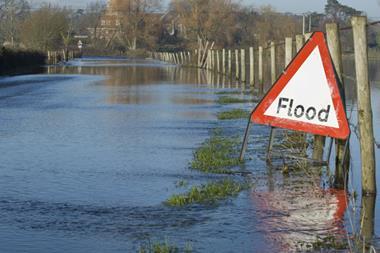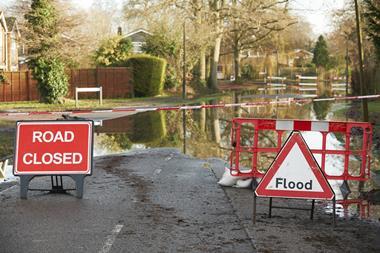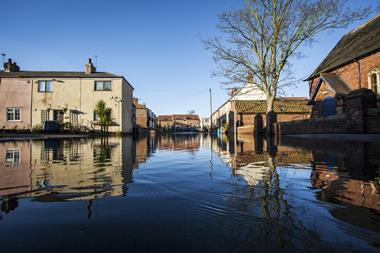The reinsurance scheme hopes its new flood resilience scoring could help underpin future insurer pricing
Installing property flood resilience (PFR) measures helps ensure “less damage to people’s homes” and saves insurers money on claims - however, the industry is “not currently able to recognise that benefit”, according to Flood Re’s communications and transition director, Dermot Kehoe, speaking exclusively to Insurance Times.
The Flood Hub, a flooding resource site for communities in the north west, noted that PFR measures include flood barriers, air brick covers, one-way weep valves or non-return valves, raised electric access points and a more considered choice around building materials, to name a few.

To encourage greater take up of PFR tools, and therefore reap the available financial benefits linked to reduced claims severity, Flood Re has established what it believes is its first “vital building block” - the creation of a scoring mechanism that reveals a property’s resistance to flood damage.
Flood Re and the Environment Agency (EA) commissioned the Middlesex University Flood Hazard Research Centre to create this flood resilience scoring methodology in 2022.
Designed to assess property flood risk for buildings that have been fitted with flood resilience measures, this scoring system underpinned a pilot scheme Flood Re initiated in East Peckham, Kent, between October 2022 and February 2023.
In East Peckham, residents regularly face pluvial and fluvial flooding due to the village’s proximity to the River Medway, the Coult Stream and the River Bourne.
Exactly 30 properties participated in the pilot, including terraced, semi-detached and detached buildings that covered five different flood resilience and recoverability scenarios.
The PFR steps displayed in these properties ranged from having no measures installed at all, to buildings having 60cm of protection - this allows up to 5mm of internal leak damage only.
The properties chosen for the pilot were selected from the EA’s PFR scheme, which provides PFR measures such as flood doors, non-return valves and flood barriers to homeowners that have experienced previous internal flooding or for properties that are considered a significant flood risk.
Following the initial pilot duration, Middlesex University will now use its new methodology to score the participating properties and produce a prototype Flood Performance Certificate (FPC) for each building - this can then be used by insurers, lenders, local authorities and individuals to compare homes’ resiliency to flooding.
Similar to Energy Performance Certificates, FPCs aim to provide a clear overview of the flood risk posed to a property and what action can be taken to mitigate the risk.
The Social Market Foundation initially launched the concept of FPCs in 2018. Flood Re formally backed the use of FPCs in December 2020 by designing a blueprint around how they could be used.
The ABI approves of FPCs.
A spokesperson told Insurance Times: “As the risk of flooding continues to increase due to climate change, it is vital more is done to better protect communities and make them more resilient to flooding.
”The introduction of Flood Performance Certificates is one way of improving the use of resilient building measures and to improve customer awareness of their flood risk.
”However, further work is needed to consider practical and implementation issues. We and our members remain committed to working with government and customers to help society adapt and be more resilient to volatile weather.”
Still ‘a lot more work to be done’
Flood Re’s final report associated with the East Peckham pilot is due to be completed this month (March 2023).
Following this, the reinsurance scheme hopes to make the scoring methodology provided by Middlesex University “useable across Britain”, to incentivise homeowners to repair properties in a way that is resilient to future flooding and reduce the stigma it believes is associated with flood risk.
Read: Insurers’ capital outlook darkened by increasing climate risk – GlobalData
Read: Parametric insurance poses ‘really compelling’ solution to climate change driven weather events
Explore more sustainability-related content here and discover more news content here.
Flood Re believes the scoring system can also create quicker recoveries for insureds and reduce insurers’ costs around having to source alternative accommodation, for example.
Kehoe added that the end “aspiration” of the pilot project is for insurers to eventually price policies dependent on these scores.
However, before insurers can change their pricing models, there is “a lot more work to be done”.
This includes developing a “proper, full methodology” by conducting similar pilots across different geographies and flooding types - to accommodate river, surface and coastal flooding, for example - as well as completing ”academic research and hydrological modelling”.
Flood Re is additionally encouraging insurers, lenders and model providers to offer their suggestions on potential minimum viable products to combat flood risks, following the publication of its report later this month.
Kehoe expected this follow up work to be finished over the next 18 to 24 months.
‘Great triumph’ so far
Looking ahead, Flood Re is planning to further scale its scoring initiative by exploring the creation of a complimentary smartphone app. It also wants to consider intangible flooding influences, whereas the East Peckham pilot focused on physical characteristics in the home.
Despite the work Flood Re is currently doing, Kehoe highlighted that he would be “concerned” whether the “PFR sector could cope” if there was a “big flood event” because this would create “real strains” on supply chains. He attributed this to the fact that “flood risk is getting worse thanks to climate change”.
Although the East Peckham pilot signalled only the first phase of Flood Re’s scoring mechanism project, Kehoe is pleased with the programme’s progress to date. He described the pilot as a “great triumph”.












































No comments yet